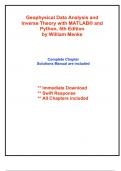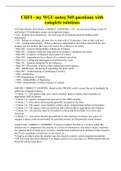Geophysical Data Analysis and
Inverse Theory with MATLAB® and
Python, 5th Edition
by William Menke
Complete Chapter
Solutions Manual are included
** Immediate Download
** Swift Response
** All Chapters included
,Solutions to Problems
Geophysical Data Analysis and Inverse Theory with MATLAB® and Python
Fifth Edition
2.1 Suppose that you determine the masses of 100 objects by weighing the first, then weighing
the first and second together, and then weighing the rest in triplets: the first, second, and third;
the second, third, and fourth; and so forth. (A) Identify the data and model parameters in this
problem. How many of each are there? (B) Write down the matrix, 𝐆, in the equation, 𝐝 = 𝐆𝐦,
that relates the data to the model parameters. (C) How sparse is 𝐆? What percent of it is zero
(A) The 100 masses of the objects are the model parameters. The 100 weights, as determined by
a scale, are the data. (B) The data kernel is 100×100
1 0 0 0 0 0 ⋯ 0
1 1 0 0 0 0 ⋯ 0
1 1 1 0 0 0 ⋯ 0
𝐆= 0 1 1 1 0 0 ⋯ 0
0 0 1 1 1 0 ⋯ 0
⋱
[0 0 0 0 0 1 1 1 ]
(C) The data kernel has 10,000 elements, of which about 300 are non-zero, so it is about
9,700/10,000 = 97% zero.
2.2 Suppose that you determine the height of 50 objects by measuring the first, and then stacking
the second on top of the first and measuring their combined height, stacking the third on top of
the first two and measuring their combined height, and so forth. (A) Identify the data and model
parameters in this problem. How many of each are there? (B) Write down the matrix, 𝐆, in the
equation, 𝐝 = 𝐆𝐦, that relates the data to the model parameters. (C) How sparse is 𝐆? What
percent of it is zero?
(A) The 50 heights of the objects are the model parameters. The 50 heights of the stack, as
measured by a ruler, are the data. (B) The data kernel is 50×50
1 0 0 0 0 0
⋯ 0
1 1 0 0 0 0
⋯ 0
1 1 1 0 0 0
⋯ 0
𝐆= 1 1 1 1 0 0
⋯ 0
1 1 1 1 1 0
⋯ 0
⋱
[1 1 1 1 1 1 1 1 ]
(C) The data kernel has 2500 elements, of which somewhat less than half are non-zero, so it is
about 50% zero.
,2.3 Write a MATLAB® or Python script to compute 𝐆 in the case of the cubic equation, 𝑇 =
𝑇 = 𝑎 + 𝑏𝑧 + 𝑐𝑧 2 + 𝑑𝑧 3 . Assume that 11 𝑧s are equally spaced from 0 to 10.
See scripts gdasolnma02_03 and gdasolnpy02_03.
2.4 Let the data, 𝐝, be the running average of the model parameters, 𝐦, computed by averaging
groups of three neighboring points; that is, 𝑑𝑖 = ⅓𝑚𝑖−1 + ⅓𝑚𝑖 + ⅓𝑚𝑖+1 . (A) What is the
matrix, 𝐆, in the equation, 𝐝 = 𝐆𝐦, in this case? (B) What problems arise at the top and bottom
rows of the matrix and how can you deal with them? (C) How sparse is 𝐆? What percent of it is
zero?
(A) The data kernel is N×M where N=M-4, and has the form
1 1 1 0 0 0 ⋯ 0
1 0 1 1 1 0 0 ⋯ 0
𝐆= 0 0 1 1 1 0 ⋯ 0
3
⋱
[0 0 0 0 0 1 1 1]
(B) Note that we can regard the running average di=(mi-1,mi,mi+1) as being centered about
model parameter mi. However, no datum represents an average centered about model
parameters 1, 2, M-1 or M. One could possible deal with them by adding two rows at the top and
two at the bottom, such as
1 0 0 0 0 0 ⋯ 0
1/2 1/2 0 0 0 0 ⋯ 0
1/3 1/3 1/3 0 0 0 ⋯ 0
0 1/3 1/3 1/3 0 0 ⋯ 0
𝐆= 0 0 1/3 1/3 1/3 0 ⋯ 0
⋱
0 0 0 0 0 1/3 1/3 1/3
0 0 0 0 0 0 1/2 1/2
[ 0 0 0 0 0 0 0 0 ]
These rows are not three-point running averages, but at least they are roughly centered about the
first and last pairs of model parameters. (C) The sparseness of the data kernel depends upon its
size. About 100×(M-3)/M = 100×(1-3/M) percent of its elements are zero.
2.5 Simplify Eq. (2.22) by assuming that there is only one sample, 𝑆1𝑗 , whose composition is
measured. Consider the case where the composition of the 𝑃 factors is known, but their
proportions in the sample are unknown, and rewrite the equation in the form, 𝐝 = 𝐆𝐦. Hint:
You might start by taking the transpose of Eq. (2.22).
, The equation becomes
𝑆11 𝐹11 𝐹21 ⋯ 𝐹𝑝1 𝐶11
𝑆 𝐹 𝐹22 ⋯ 𝐹𝑝2 𝐶12
[ 12 ] = 12 [ ]
⋮ ⋮ ⋮ ⋯ ⋮ ⋮
𝑆1𝑀 𝐹
[ 1𝑀 𝐹2𝑀 ⋯ 𝐹𝑝𝑀 ] 𝐶1𝑀
The composition of the sample is measured, so they the data. The factor loadings are unknown,
so they are the model parameters. The equation is then form d=Gm, as long as we presume that
the composition of the factors are known.
3.1 What is the mean and variance of the uniform distribution, 𝑝(𝑑) = 1 on the interval, (0,1)?
The mean and variance are:
1 1
𝑑2
〈𝑑〉 = ∫ 𝑑 d𝑑 = | =½−0=½
0 2 0
1 1
2
1
2
1
𝑑3 𝑑2 𝑑1 1 1 1 4 6 3 1
𝜎 = ∫ (𝑑 − ½) d𝑑 = ∫ (𝑑2 − 𝑑 + ¼) d𝑑 = | − | + | = − + = − + =
0 0 3 0 2 0 4 0 3 2 4 12 12 12 12
This result can be used in script, as in gdasolnma03_01 and gdasolnpy03_031
3.2 Suppose 𝑑 is a Normal random variable with zero mean and unit variance. What is the
probability density function of 𝐸 = 𝑑2 ? Hint: Since the sign of 𝑑 gets lost when it is squared,
you can assume that 𝑝(𝑑) is one-sided, that is, defined for only 𝑑 ≥ 0 and with twice the
amplitude of the usual Normal pdf.
The p.d.f. of a Gaussian-distributed variable with zero mean and unit variance on the interval
(0,∞) is twice the corresponding p.d.f. on the (-∞,∞) interval, or
2
𝑝(𝑒) = √ exp (−½𝑒 2 )
𝜋
Given the function E=e2, or e=E½, we note that (0,∞) on e corresponds to (0,∞) on E. The
derivative is de/dE = ½E-½. The p.d.f. for E is then:
𝑑𝑒 2 1 1
𝑝(𝐸) = 𝑝(𝑒(𝐸)) | | = √ exp (−½𝐸) = √ exp (−½𝐸)
𝑑𝐸 𝜋 2√𝐸 2𝜋𝐸





